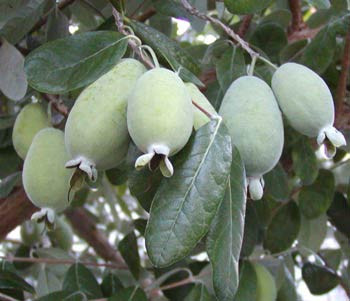
To grow pineapple guava, also known as Feijoa or Acca sellowiana, you can follow these steps:
Climate: Pineapple guava is best suited for mild to warm subtropical or Mediterranean climates. It can tolerate light frost but may require protection in colder regions. It prefers temperatures between 60-80°F (15-27°C).
Sunlight: Pineapple guava plants thrive in full sun to partial shade. Choose a location that receives at least 6-8 hours of direct sunlight per day.
Soil: Pineapple guava prefers well-draining soil with a pH range of 6.0-7.5. Amend heavy or clay soil with organic matter such as compost to improve drainage. Avoid waterlogged or overly compacted soil.
Planting: You can start pineapple guava from seeds or purchase young plants from nurseries. Dig a hole that is slightly larger than the root ball of the plant. Place the plant in the hole, ensuring that the crown (where the stems meet the roots) is level with the soil surface. Backfill with soil, gently firming it around the roots.
Watering: Pineapple guava plants have moderate water needs. Water them deeply but infrequently, allowing the soil to dry out partially between waterings. Once established, they are somewhat drought-tolerant but will benefit from regular watering during dry periods.
Mulching: Apply a layer of organic mulch, such as wood chips or straw, around the base of the plant. Mulching helps retain soil moisture, suppresses weed growth, and regulates soil temperature.
Fertilizing: Pineapple guava plants are generally low-maintenance and do not require heavy fertilization. However, you can apply a balanced slow-release fertilizer in spring to promote healthy growth. Follow the instructions on the fertilizer packaging for the recommended dosage.
Pruning: Prune pineapple guava plants to maintain their shape and remove any dead, damaged, or crossing branches. Pruning is best done in late winter or early spring before new growth begins.
Pollination: Pineapple guava plants are self-fertile, but cross-pollination with another variety can increase fruit production. Planting multiple pineapple guava plants or other compatible varieties nearby can improve pollination and fruit set.
Harvesting: Pineapple guava fruits are typically ready to harvest in autumn or early winter, depending on the variety and climate. The fruits will develop a pleasant aroma and soften when ripe. Gently twist or cut the fruit from the plant when it is fully ripe.
Pineapple guava plants can take a few years to start bearing fruit, but with proper care and favorable conditions, you can enjoy the unique flavor and fragrance of their delicious fruits.

No comments:
Post a Comment